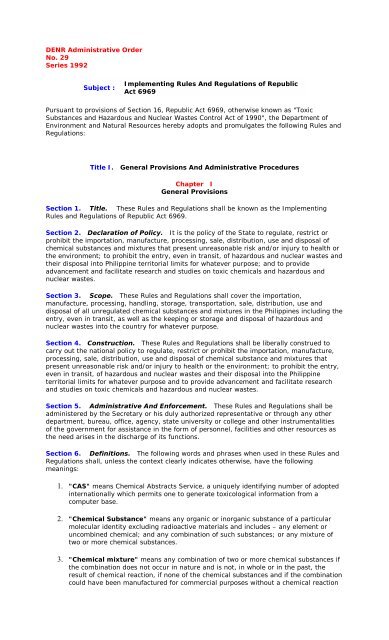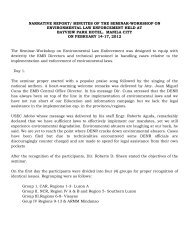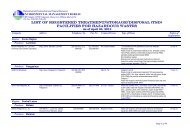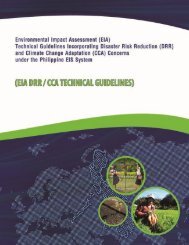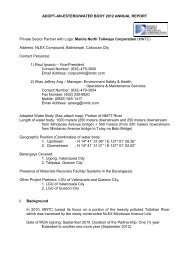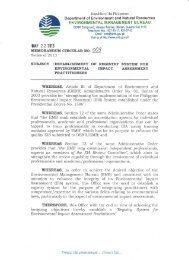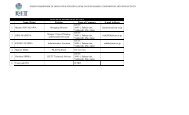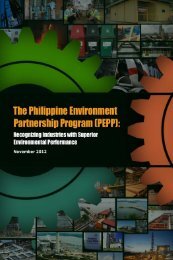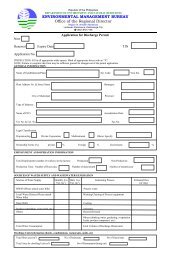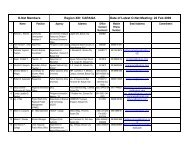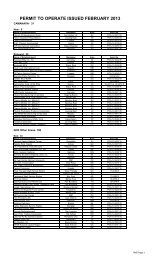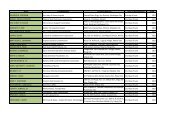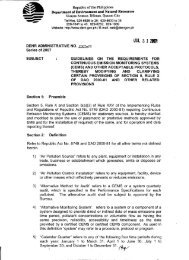denr administrative order - Environmental Management Bureau
denr administrative order - Environmental Management Bureau
denr administrative order - Environmental Management Bureau
You also want an ePaper? Increase the reach of your titles
YUMPU automatically turns print PDFs into web optimized ePapers that Google loves.
DENR Administrative OrderNo. 29Series 1992Subject :Implementing Rules And Regulations of RepublicAct 6969Pursuant to provisions of Section 16, Republic Act 6969, otherwise known as "ToxicSubstances and Hazardous and Nuclear Wastes Control Act of 1990", the Department ofEnvironment and Natural Resources hereby adopts and promulgates the following Rules andRegulations:Title I. General Provisions And Administrative ProceduresChapter IGeneral ProvisionsSection 1. Title. These Rules and Regulations shall be known as the ImplementingRules and Regulations of Republic Act 6969.Section 2. Declaration of Policy. It is the policy of the State to regulate, restrict orprohibit the importation, manufacture, processing, sale, distribution, use and disposal ofchemical substances and mixtures that present unreasonable risk and/or injury to health orthe environment; to prohibit the entry, even in transit, of hazardous and nuclear wastes andtheir disposal into Philippine territorial limits for whatever purpose; and to provideadvancement and facilitate research and studies on toxic chemicals and hazardous andnuclear wastes.Section 3. Scope. These Rules and Regulations shall cover the importation,manufacture, processing, handling, storage, transportation, sale, distribution, use anddisposal of all unregulated chemical substances and mixtures in the Philippines including theentry, even in transit, as well as the keeping or storage and disposal of hazardous andnuclear wastes into the country for whatever purpose.Section 4. Construction. These Rules and Regulations shall be liberally construed tocarry out the national policy to regulate, restrict or prohibit the importation, manufacture,processing, sale, distribution, use and disposal of chemical substance and mixtures thatpresent unreasonable risk and/or injury to health or the environment; to prohibit the entry,even in transit, of hazardous and nuclear wastes and their disposal into the Philippineterritorial limits for whatever purpose and to provide advancement and facilitate researchand studies on toxic chemicals and hazardous and nuclear wastes.Section 5. Administrative And Enforcement. These Rules and Regulations shall beadministered by the Secretary or his duly authorized representative or through any otherdepartment, bureau, office, agency, state university or college and other instrumentalitiesof the government for assistance in the form of personnel, facilities and other resources asthe need arises in the discharge of its functions.Section 6. Definitions. The following words and phrases when used in these Rules andRegulations shall, unless the context clearly indicates otherwise, have the followingmeanings:1. "CAS" means Chemical Abstracts Service, a uniquely identifying number of adoptedinternationally which permits one to generate toxicological information from acomputer base.2. "Chemical Substance" means any organic or inorganic substance of a particularmolecular identity excluding radioactive materials and includes – any element oruncombined chemical; and any combination of such substances; or any mixture oftwo or more chemical substances.3. "Chemical mixture" means any combination of two or more chemical substances ifthe combination does not occur in nature and is not, in whole or in the past, theresult of chemical reaction, if none of the chemical substances and if the combinationcould have been manufactured for commercial purposes without a chemical reaction
at the time the chemical substances comprising the combination were combined.This shall include nonbiodegradable mixtures.4. "Department" means the Department of Environment and Natural Resources.5. "<strong>Environmental</strong> Protection Officer" means an officer appointed or deputized bythe Secretary to execute the provisions of these Rules and Regulations subject toconditions, limitations or restrictions as prescribed by the Secretary.6. "Hazardous substances" are substances which present either:a. short-term acute hazards such as acute toxicity by ingestion, inhalation orskin absorption, corrosivity or other skin or eye contact hazard or the risk offire or explosion;b. long-term environmental hazards, including chronic toxicity upon repeatedexposure, carcinogenicity (which may in some case result from acuteexposure but with a long latent period, resistance to detoxification processsuch as biodegradation, the potential to pollute underground or surfacewaters, or aesthetically objectionable properties such as offensive odors.7. "Hazardous wastes" are substances that are without any safe commercial,industrial, agricultural or economic usage and are shipped, transported or broughtfrom the country of origin for dumping or disposal into or in transit through any partof the territory of the Philippines."Hazardous wastes" shall also refer to by-products , side-products, processresidues, spent reaction media, contaminated plant or equipment or othersubstances from manufacturing operations and as consumer discards ofmanufactured products which present unreasonable risk and/or injury to health andsafety and to the environment.8. Importation means the entry of a product or substance into the Philippines(through the seaports or airports of entry) after having been properly clearedthrough or still remaining under customs control, the product or substance of whichis intended for direct consumption, merchandising, warehousing, for furtherprocessing.9. "Inert waste" means any waste that, when placed in a landfill is reasonablyexpected not to undergo any physical, chemical, and/or biological changes to suchan extent as to cause pollution or hazard to public health and safety.10. "New Chemicals" means any chemical substance imported into or manufacturedin the country after December 31, 1993 and which are not included in the PhilippineInventory of Chemicals and Chemical Substances as published by the Department.11. Nuclear wastes are hazardous wastes made radioactive by exposure to theradiation incidental to the production or utilization of nuclear fuels but does notinclude nuclear fuel, or radioisotopes which have reached the final stage offabrication so as to be usable for any scientific, medical, agricultural, commercial, orindustrial purpose.12. Manufacture means the mechanical or chemical transformation of substances intonew products whether work is performed by power-driven machines or by hand,whether it is done in a factory or in the worker’s home, and whether the products aresold at wholesale or retail.13. "Occupier" is one who must have a license to accept, produce, generate, store,treat, recycle, reprocess, process, manufacture or dispose of hazardous waste.14. "Permit" means a legal authorization to engage in or conduct any or all of thefollowing activities for:a. Toxic chemicals – importation, storage, manufacture, processing, selling,transport and disposalb. Hazardous wastes – storage, treatment, transport, export, processing,reprocessing, recycling and disposalc. Hazardous materials – importation or exportation15. "Person" or "persons" includes any being, natural or juridical, susceptible ofrights and obligations or of being the subject of legal relations.
16. "Pollution" means any alteration of the physical, chemical, biological properties ofany water, air and/or and resource of the Philippines, or any discharge thereto of anyliquid, gaseous or solid waste, or any production of unnecessary noise, or anyemission of objectionable odor, as will or is likely to create or to render such water,air and/or land resources harmful, detrimental or injurious to public health, safety orwelfare, or which will adversely affect their utilization for domestic, industrial,agricultural, recreational or other legitimate purposes.17. "Premises" shall include but not limited to:a. building or part of a building;b. a tent, stall or other structure whether permanent or temporary;c. land;d. vehicle;e. boat or ship18. Process means the preparation of a chemical substance or mixture after itsmanufacture for commercial distribution:i. In the same form or physical state or in a different form or physical statefrom that which it was received by the person so preparing such substance ormixture; orAs part of an article containing a chemical substance or mixture.ii.19. "Secretary" means the Secretary of the Department of Environment and NaturalResources.20. "Transport" includes conveyance by air, water and land.21. "Waste generator" means a person who generates or produces, through anycommercial, industrial or trade activities, hazardous wastes.22. "Wastewater transporter" means a person who is licensed to treat, store,recycle, or dispose of hazardous wastes.23. "Waste treater" means a person who is licensed to treat, store, recycle, ordispose of hazardous wastes.24. "Unreasonable risk" means expected high frequency of undesirable effects oradverse responses arising from a given exposure to a substance.Chapter IIAdministrative ProvisionSection 7. Powers and Functions Of The Department Of Environment AndNatural Resources. The Department of Environment and Natural Resources shall betasked with the following functions, powers and responsibilities:a. To keep an updated inventory of chemicals that are presently beingmanufactured or used, indicating among others, their existing and possibleuses, quantity, test data, names of firms manufacturing or using them, andsuch other information as the Secretary may consider relevant to theprotection of health and the environment;b. To require chemical substances and mixtures that present unreasonable riskor injury to health or to the environment to be tested before they aremanufactured or imported for the first time;c. To require chemical substances and mixtures which are presently beingmanufactured or processed to be tested if there is reason to believe that theypose unreasonable risk or injury to health and the environment;d. To evaluate the characteristics of chemicals that have been tested todetermine their toxicity and the extent of their effects on health and theenvironment;e. To enter into contracts and make grants for research, development andmonitoring of chemical substances and mixtures;
f. To conduct inspection of any establishment in which chemicals aremanufactured, processed, stored or held before or after their commercialdistribution and to make recommendations to the proper authoritiesconcerned;g. To confiscate or impound chemicals found not falling within the standards setby these Rules and Regulations and the said acts cannot be enjoined exceptafter the chemicals have been impounded;h. To monitor and prevent the entry, even in transit, of hazardous and nuclearwastes and their disposal into the country;i. To subpoena witnesses and documents and to require other information ifnecessary to carry out the provisions of this Act;j. To call on any department, bureau, office, agency, state university or college,and other instrumentalities of the Government for assistance in the form ofpersonnel, facilities and other resources as the need arises in the discharge ofits functions;k. To disseminate information and conduct educational awareness campaign onthe effects of chemical substances, mixtures and wastes on health andenvironment; andl. To exercise such powers and perform such other functions as may benecessary to carry out its duties and responsibilities under RA 6969.Section 8. Delegation Of Powers And Functions Of The Secretary1. The Secretary may appoint and/or deputize officers subject to conditions, limitationsor restrictions as may be prescribed by him.2. The Secretary may delegate his powers to:a. conduct inspection of any establishment in which chemicals aremanufactured, processed, stored or held before or after their commercialdistribution and to make recommendations to the proper authoritiesconcerned;b. conduct inspection of any premises in which hazardous wastes are beinggenerated, stored, processed, reprocessed, recycled, treated and/or disposedof and to make recommendations to the proper authorities;c. stop, detain, inspect, examine and remove to some suitable place forinspection and examination any vehicle or boat that is believed to being orlikely to be used for the transport of chemical substances and hazardous andnuclear wastes subject to pertinent provisions of these Rules and Regulations;d. monitor and prevent the entry, even in transit, of hazardous and nuclearwastes and their disposal into the country;e. subpoena witnesses and documents and to require other information ifnecessary to carry out the provisions of these Rules and Regulations.3. The Secretary may, by notice, amend or revoke the:a. delegated authorities previously granted under Section 8(2) of these Rulesand Regulations; andb. appointed of an <strong>Environmental</strong> Protection Officer.Section 9. Duties And Responsibilities Of An <strong>Environmental</strong> Protection Officer.An <strong>Environmental</strong> Protection Officer shall have the following duties and responsibilities:a. To make such examination or inquiry as is necessary to determine whetherthese Rules and Regulations are being complied with.b. To enter any premises in which he reasonable believes that chemicalsubstance or hazardous waste are being used, manufactured, stored,processed, reprocessed, generated, treated, transported or disposed of andmay –i. without payment take or require the occupier or person in charge ofthe premises or person in possession of any chemical substance togive the <strong>Environmental</strong> Protection Officer samples of the chemicalsubstance for examination and testing subject to pertinent provisionsof these Rules and Regulations.require the production of any relevant documents and inspect,examine and make copies of or extracts from them or remove them tomake a copy of extract; andii.
iii.take such photographs or audio or visual recordings as he considersnecessary.c. To stop, detain, inspect, examine and remove to some suitable place forinspection and examination any vehicle or boat that he believes is being orlikely to be used for the transport of chemical substances and hazardouswastes without the necessary permit from the Department.d. To require a person found committing an offense under these Rules andRegulations to state the person’s full name and address.e. To exercise such other duties and responsibilities as may be authorized by theSecretary.Section 10. Confiscation, Impoundment And Imposition Of AdministrativeFines. Upon receipt of a report from a duly authorized inspector or upon a verifiedcomplaint from a private person, the Secretary or his duly authorized representative shall<strong>order</strong> an investigation or inquiry in such a manner as he may determine on the allegedviolation of any of the provision of RA 6969 and these Rules and Regulations. If afterinvestigation there appears to be a violation of any of the provisions of RA 6969 or theseRules and Regulations, the Secretary or his duly authorized representative shall issuesummons informing respondent/s of nature of charges against him and requiring the saidrespondent or respondents to appear before him or his duly designated representative for aconference for the purpose of determining whether an Order for confiscation orimpoundment or fine should be issued.Section 11. Ex-Parte Order Of Confiscation Or Impoundment. Whenever theSecretary or his duly authorized representative finds a prima facie evidence that theviolation presents unreasonable risk and/or injury to health or the environment, theSecretary or his duly authorized representative may issue an Ex-Parte Order of confiscationor impoundment, provided that the respondent files his Motion for Reconsideration withinten (10) days from date of confiscation or impoundment which Motion for Reconsiderationshall be resolved within fifteen (15) days from receipt of the same.Chapter IIIInter-Agency Technical Advisory CouncilSection 12. Composition Of The Inter-Agency Technical Advisory Council. Theinteragency Technical Advisory Council shall be composed of the following officials or theirduly authorized representatives:Secretary of Environment and Natural ResourcesSecretary of HealthSecretary of Trade and IndustrySecretary of Science and TechnologySecretary of National DefenseSecretary of Foreign AffairsSecretary of Labor and EmploymentSecretary of FinanceSecretary of AgricultureSecretary of Philippine Nuclear Research InstituteRepresentative from non-governmental organizationsOn health and safetyChairmanMemberMemberMemberMemberMemberMemberMemberMemberMemberMemberThe representative from the non-governmental organization shall be appointed by thePresident for a term of three (3) years.
Section 13.Functions Of The Council. The Council shall have the following functions:a. To assist the Department in the formulation of these rules and regulations forthe effective implementation of RA 6969;b. To assist the Department in the preparation and updating of the inventory ofchemical substances and mixtures that fall within the coverage of RA 6969;c. To conduct preliminary evaluation of the characteristics of chemicalsubstances and mixtures to determine their toxicity and effects on health andthe environment and make the necessary recommendations to theDepartment; andd. To perform such other functions as the Secretary may, from time to time,require.Title II.Toxic Chemical SubstancesChapter IVInventory of Chemical SubstancesSection 14. Chemical Substances Inventory (click for the Annual Chemicals InventoryChecklist Form)1. The Secretary or his duly authorized representative shall cause the keeping,updating, compilation and maintenance of an inventory of chemical substances whichare stored, imported, exported, used, processed, manufactured or transported.2. The inventory shall contain such information that the Secretary or his dulyauthorized representative considers to be relevant to the protection of health and theenvironment.3. The Secretary or his duly authorized representative shall cause the release of anupdated listing of the inventory comprising the chemical substance’s name and itsCAS number.Section 15. Pre-manufacturing And Pre-Importation Data Requirements (click forthe PMPIN Abbreviated Form)1. The desired information for a nomination of a chemical substance under Section 16and the required information for a notification of a chemical substance under Section17 shall comprise –a. its proper chemical name;b. its trade name or names;c. its chemical and molecular structure;d. its CAS number;e. its RTECS number (if available)f. its United Nations number (if applicable)g. its United Nations class and subsidiary risk category (if applicable);h. the following physical characteristics (if applicable) –i. boiling point;ii. melting point;specific gravity;vapor pressure;v. appearance;odor;purity; andwater/octanol partition coefficient;iii.iv.vi.vii.viii.i. the following chemical properties (if applicable)i. solubility in water; andii. solubility in an organic solvent;j. the following toxicological data (if applicable) –i. measured lethal dose (median) in two species;
ii.iii.iv.measured lethal concentration (median) in two species;results of an irritation test on the skin and eyes of species;results of a short-term sub-lethal toxicity test on one speciesk. any recommended time weighted exposure average (eight hour working day);l. its flash point measured under close cup conditions;m. its upper and lower explosive limits (if applicable);n. its known stability and incompatibilities;o. its carcinogenic, teratogenic and mutagenic properties;p. the name and address of the nominating person; andq. the anticipated volume in cubic meters or weight in tones, per annum of thechemical substance being used, stored, manufactured, processed, offered forsale or sold, transported, imported and exported by the nominating person.2. The documents containing the above information shall be considered as publicdocument.Section 16.Nomination Of Existing Chemicals1. Until 31 December 1993, a person shall submit to the Department for inclusion in thePhilippine Inventory of Chemicals and Chemical Substances, a list of chemicalsubstances which are currently used, sold, distributed, imported, processed,manufactured, stored, exported or transported in the Philippines in a form as may beprovided by the Department. (click for the PICCS Updating Form)2. The person who nominates a chemical substance shall provide as much informationas outlined in Section 15 of these Rules and Regulations and that such nominationshall contain the following minimum data:a. chemical namesb. trade name or namesc. chemical structured. CAS numbere. anticipated volume in cubic meters, or weight in tones per annum ofchemicals being nominatedf. name and address of nominating person.3. Chemical substances in the chemical inventory shall be regarded by the Departmentas existing chemical substances and, therefore, exempted from the provisions ofSection 17.4. The Department shall not accept any further nominations of chemical substancesunder this section after 31 December 1993.Section 17. Notification Of New Chemicals (click for the Notice of Commencement(manufacture or import) Form)1. After 31 December 1993, a chemical substance which is not included in the chemicalinventory shall be considered as new chemical substance. (click for the BiennualReport Form)Unless exempted, any person who uses, stores, imports, manufactures, transports orprocesses a chemical substance after 31 December 1993 which is not listed in thechemical inventory shall be liable for violation of Section 16 of these Rules andRegulations and shall be dealt with subject to the provisions of Section 15 of RA6969.2. No person shall use, store, transport, import, sell, distribute, manufacture, orprocess a new chemical substance unless permitted by the Department. Permit shallbe granted under the following conditions:a. The Department must be notified of the intention to do so at least onehundred and eighty (180) days before commencing such activity; andb. The Department shall be provided with such information as outlined in Section15;
3. The notification must be made in accordance with a form and in a manner prescribedby the Department and accompanied with the payment of the prescribed fee.4. The notification which does not comply with the requirement of Section 17(3) will notbe acted and/or accepted.5. The Department shall have the discretion not to include the new chemical substancein the chemical inventory if the information provided to the Department by theperson does not fully comply with the requirements of Section 15 or the Departmentsuspects that the data are of dubious quality.6. Any person who falsifies information on a chemical substance while nominating anexisting or new chemical substance shall be criminally liable.Section 18.Assessment Of Chemicals1. Upon notification of a new chemical substance under Section 17 of these Rules andRegulations, the Department shall within ninety (90) days determine whether –a. to add the chemical substance to the chemical inventory;b. to seek further information to any person for the purpose of assessing publichealth and environmental risk posed by the use, storage, manufacture,import, process or transport of the chemical substance or;c. to issue Chemical Control Order in accordance to Section 20 of these Rulesand Regulations.2. The Department shall notify the applicant in writing of its decision.Section 19.Priority Chemical List1. The Department shall compile and may amend from time to time a list to be knownas the Priority Chemicals List.2. The Department may determine which chemical substance from the chemicalinventory should be included, deleted, or excluded from the Priority Chemicals List.3. The Department shall publish in the Official Gazette or newspaper of generalcirculation the Priority Chemicals List and any amendments and deletions to the List.4. The Department may require information from any person for the purpose ofassessing the public and environmental risk posed by the use, storage, manufacture,import, process or transport of the priority chemicals.Section 20.Chemical Control Orders1. If the Department has determined that the use, storage, transport, process,manufacture, import or export of any new substance or a priority chemical poses anunreasonable risk or hazard to public health or the environment, the Department,may, by <strong>order</strong> published in the Official Gazette or any newspaper or generalcirculation:a. prohibit the use, manufacture, import, export, transport, process, storage,possession or sale of the chemical substance;b. limit the use, manufacture , import, export, transport, process, storage,possession or sale of the chemical substances; orc. place such controls or conditions on the use, manufacture, import, export,transport, process, storage, possession or sale of the chemical substance toabate or minimize risks or hazards posed by the chemical substances onpublic health and environment.2. An <strong>order</strong> issued by the Department under Section 20(1) shall be known as ChemicalControl Order.
Chapter VTesting RequirementsSection 21. Chemicals Subject To Testing1. Testing shall be required in all cases where:a. There is reason to believe that the chemical substances or mixture maypresent an unreasonable risk to health or environment;b. There is insufficient data and experience for determining or predicting thehealth and environmental effects of the chemical substance or mixture; andc. The testing of the chemical substance or mixture is necessary to develop suchdata.2. The manufacturers, processors or importers of such chemicals subjected to testingshall shoulder the costs of testing the chemical substance or mixture.Chapter VIExemptionsSection 22. Exemptions. The following substances and mixtures shall be exemptedfrom the requirements of Section 17, 18 and 21 of these Rules and Regulations:1. Those chemicals already included in the Philippine Inventory of Chemicals andChemical Substances;2. Those to be produced or used in small quantities solely for experimental or researchand development purposes;3. Those that are reaction intermediates which do not leave the closed productionsystem or undergo intermediate storage during the reaction process;4. Those chemical substances that are regulated by laws other than RA 6969.Section 23.Confiscation1. The Secretary or his duly authorized representative may cause the impoundment orconfiscation of any chemical substance and its conveyance and container if there isreasonable grounds to believe that:a. the sale, storage, possession, use, manufacture, transport, import, or exportfor a chemical substance does not comply with the Chemical Control Order; orb. the sale, storage, possession, use, manufacture, transport, import or exportof chemical substance poses an immediate threat or hazard to public healthand safety or the environment.2. Any costs incurred by the Department under Section 23(1) shall be reimbursed bythe occupier of the premises from which the <strong>Environmental</strong> Protection Officerimpounded or confiscated the chemical substance.Title III.Hazardous And Nuclear WastesChapter VIIHazardous WasteSection 24.Policy1. It shall be the policy of the Department to prohibit the entry even in transit ofhazardous wastes and their disposal into the Philippine territorial limits for whateverpurpose.
2. The Department encourages proper management of hazardous wastes generatedwithin the country by promoting, in <strong>order</strong> of preference:a. minimization of the generation of hazardous waste;b. recycling and reuse of hazardous wastec. treatment of hazardous waste to render it harmless; andd. landfill of inert hazardous waste residues.3. Hazardous waste shall be managed in such a manner as not to cause or potentiallycause –a. pollution;b. state of danger to public health, welfare and safety;c. harm to animals, bird, wildlife, fish or other aquatic life;d. harm to plants and vegetation; ore. limitation in the beneficial use of a segment of the environment.4. The waste generator shall be responsible for the proper management and disposal ofthe hazardous waste.5. The waste generator shall bear the costs for the proper storage, treatment anddisposal of their hazardous waste.Section 25.Classification Of Hazardous Waste1. The classes and subcategories of wastes listed in Table 1 shall be prescribed ashazardous waste for the purpose of these Rules and Regulations.2. The types of wastes listed in Table 2 shall be exempted from the requirements ofthese Rules and Regulations.3. The listings provided for Tables 1 and 2 are not inclusive and shall be subject toperiodic review.Table 1. Prescribed Hazardous WastesClass Subcategory Waste NumberPlating WastesDiscarded plating solutions and salts with a cyanideconcentration of less than 200 ppm.A101Discarded heat treatment solutions and salts with acyanide concentration of less than 200 ppm.A102Plating solutions and salts containing cyanides at aconcentration exceeding 200 ppm.A103Heat treatment solutions and salts containing cyanides ata concentration exceeding 200 ppm.A104Complexed cyanide solutions and salts.A105Other cyanide wastes arising from the plating and heattreatment industries.A199Acid WasteSulfuric AcidB201Hydrochloric AcidB202Nitric AcidB203Phosphoric AcidB204Hydrofluoric AcidB205
Mixture of Sulfuric and Hydrochloric AcidB206Other inorganic acidsB207Organic acidsB208Other mixed acidsB299Alkali WastesCaustic sodaC301PotashC302Alkaline cleanersC303Ammonium HydroxideC304Lime slurriesC305Lime-neutralizedmetal sludgesC306Other alkaline materialsC399Inorganic ChemicalWastesNontoxic saltsD401Arsenic and its compoundD402Boron compoundsD403Cadium and its compoundsD404Chromium compoundsD405Lead compoundsD406Mercury and mercuric compoundsD407Other salts and complexesD499Reactive ChemicalWastesOxidizing agentsD501Reducing agentsD502Explosive and unstable chemicalsD503Highly reactive chemicalsD599Paints/ Aqueous-based E601ResinsSolvent-basedE202/Latices/inksDyes/Adhesives/Organic SludgesOther mixedE699Organic SolventsFlash point>61 o CF701Flash point
Organic WastesAnimal/abattoir wastesG801Grease trap wastes from industrial orCommercial premisesG802OthersG899TextileTannery wastesH901Other textile wastesH999OilWaste oilsI101Interceptor sludgesI102Vegetable oilsI103Waste tallowI104Oil/water mixturesI105ContainersPortable containers previously containing toxic chemicalsubstancesJ201ImmobilizedWastesSolidified and polymerized wastesChemically fixed wastesK301K302Encapsulated WastesK303Organic ChemicalsAliphaticsL401Aromatics and phenolicsL402Highly odorousL403Surfactants and detergentsL404Halogenated solventsL405Polychlorinated biphenyls and related materialsL406Other organic chemicalsL499Miscellaneous Wastes Pathogenic or infectious wastesAsbestos wastesM501M502Pharmaceuticals wastes and drugsPesticidesM503M504Table 2.Exempted WastesDescriptionGarbage from domestic premises and householdsIndustrial and commercial wastewaters which are disposed of on-site through the sewagesystemIndustrial and commercial solid wastes which do not contain prescribed hazardous wastes asidentified in Table 1.
Materials from building demolition except asbestosSeptic tank effluents and associated sullage wastewaters.Untreated spoils from mining, quarrying and excavation works but not materials in thenature of tailings, commercially treated materials and mine facility consumables.Section 26.Waste Generators1. All waste generators shall:a. notify the Department of the type and quantity of wastes generated inaccordance with the form and in a manner approved by the Department andaccompanied by a payment of the prescribed fee; and ( click for the Hazardous WasteRegistration Form )b. provide the Department, on a quarterly basis, with information to include thetype and quantity of hazardous waste generated, produced or transportedoutside, and such other information as may be required. (click for the HazardousWaste Quarterly Reporting Form)2. A waste generator shall continue to own and be responsible for the hazardous wastegenerated or produced in the premises until the hazardous waste has been certifiedby the waste treater as had been treated, recycled, reprocessed or disposed of.3. A waste generator shall prepare and submit to the Department comprehensiveemergency contingency plans to mitigate and combat spills and accidents involvingchemical substances and/or hazardous waste. These plans shall conform with thecontent of the guidelines issued by the Department.4. A waste generator shall be responsible for training its personnel and staff on-a. the implementation of the plan required under Section 26(3); andb. the hazard posed by the improper handling, storage, transport, and use ofchemical substances and their containers.Section 27.Waste Transporter1. No transport of hazardous waste shall be allowed unless prior permit is secured fromthe Department.2. Any application for the issuance or amendment of a permit to transport hazardouswaste shall be made in accordance with the form and in a manner approved by theDepartment and accompanied by a payment of the prescribed fee.3. The Department shall maintain a register of waste transporters. (click for the NewTransporter (Permit to Transport) Form)4. A waste generator shall only use waste transporters duly authorized by theDepartment to transport hazardous wastes. (click for the List of Transporters)Section 28.Waste Transport Record1. A waste transport record shall be in a form prescribed by the Department and shallcontain the following particulars –a. the name and address of the waste generator;b. the name of the waste transporter used to transport a load of hazardouswastes;c. the registration number of the waste transport vehicle;d. the waste treatment license of the waste transporter;
e. the description of the hazardous waste transporter including its class andsubcategories as stated in Table 1;f. the quantity of the hazardous waste transported;g. the type of container used during the transport;h. the name and address of transit points and the final destination of thehazardous waste; andi. the intended method of hazardous waste treatment, storage, export,recycling, processing, reprocessing or disposal at the destination.2. Prior to the transport of hazardous wastes, the waste generator shall complete, induplicate, portions that refer to the waste generator in the prescribed form and shallsubmit the same to the Department accompanied by payment of the prescribed fee.(click for the Uniform Hazardous Waste Manifest Form)3. The waste generator shall retain and store a copy of the waste transport record for aperiod of twenty-four (24) months from the date of receipt of Department.4. Prior to the transport of the hazardous waste, the waste transporter shall complete,in duplicate, portions referring to the waste transporter in the prescribed form.5. The waste transporter shall place a copy of the waste transport record in the driver’scabin of the waste transport vehicle.6. Upon arrival at the waste treatment, storage, recycling, reprocessing, processing ordisposal premises, the waste transporter shall give a copy of the waste transportrecord to the waste treater.7. Upon receiving a waste transport record, the waste treater shall:a. verify the accuracy of the waste description of the hazardous waste;b. complete portions of the waste treater on the waste transport record; andc. retain and store the complete waste transport record for a period of twentyfourmonths after receipt of the hazardous waste.8. If the hazardous waste data is inaccurate the waste treater shall immediately informthe waste generator of such inaccuracy within a reasonable period of time. Thewaste treater shall have the right to deny acceptance of such hazardous waste ifsuch acceptance may cause any danger of hazard in the operation of its premises;9. If the hazardous waste is accepted by the waste treater for treatment, storage,export, recycling, reprocessing, processing or disposal, the waste treater shall certifyin writing, the acceptance of the hazardous waste to the waste generator.9. The waste treater shall send to the Department within five (5) days, the certificationrequired under Section 28(9) copy furnished the waste generator.10. Any waste transporter while transporting hazardous waste is involved in an accidentwhich results in the spillage or release of the hazardous waste tot he environmentshall immediately contain the spillage and notify the Department.Section 29.Hazardous Waste Storage And Labeling1. Vessels, containers and tanks for the storage of hazardous waste shall be clearlylabeled and this labeling shall comprise the following particulars –a. the class of the hazardous waste as specified in Table 1;b. the sub-category of the hazardous waste as specified in Table 1;c. the waste number as specified in Table 1;d. the name and address of the waste generator; ande. the maximum capacity of volume.2. The labeling of the vessels, containers and tanks specified in Section 29(1) shall beconspicuously marked in paint, decals or other permanent form of markings.Section 30.Waste Treatment And Disposal Premises
1. No waste treater shall accept, store, treat, recycle, reprocess or dispose of hazardouswastes unless done in the premises as prescribed in Table 3 and permitted by theDepartment.Table 3.Prescribed Wastes Treatment PremisesCategoryDescriptionA. Premises that conduct on-site disposal of hazardous wastes generatedor produced at the premises through industrial or commercial processesand activities other than disposal via sewer.B. Commercial or industrial hazardous waste incinerators.C. Landfills, dumps or tips that accept hazardous waste for disposalD. Premises that recycle or reprocess hazardous waste which were notgenerated or produced at that premise.E. Premises that immobilize, encapsulate, polymerize or treat hazardouswastes which were not generated or produced at that premise.F. Premises that store hazardous wastes, which were not generated orproduced at that premise for periods exceeding thirty (30) days.2. An application for issuance or amendment of a permit under this section shall bemade in accordance with a form and in a manner approved by the Departmentaccompanied with the payment of the prescribed fee and accompanied by suchplans, specifications and other information and a summary thereof as may berequired by the Department.3. The Department shall maintain a register of waste treaters. (click for the List ofRecognized Recyclers/Treaters of Hazardous Waste)Section 31.Import And Export Of Hazardous Substances1. Any person who wishes to import into the Philippines or export hazardous substancesmust seek and obtain prior written approval from the Department.2. An application made under Section 31(1) shall be made in the form and mannerapproved by the Department and accompanied by payment of the prescribed fee.3. The Department shall cause the seizure of the imported hazardous substances whichdoes not comply with the approved permit, return the hazardous substance to theirpoint of origin and initiate proceedings to recover cost incurred.Chapter VIIINuclear WasteSection 32.Policy1. It shall be the policy of the government to prohibit the entry, even in transit, ofnuclear waste and their storage or disposal into the Philippine territorial limits forwhatever purpose.2. The Philippine Nuclear Research Institute (PNRI) shall be the government agencyresponsible for the regulation and licensing of nuclear facilities and radioactivematerials pursuant to the provisions of R.A. 2067, the Science Act 56 of 1958, andR.A. 5207, the Atomic Energy Regulatory and Liability Act of 1968, both as amended.Radioactive material as defined in the laws include radioactive products or wastes.Section 33.Specific Exemption
1. The following are exempt from the requirements of these regulations:a. Any holder of a valid PNRI license authorized to operate a nuclear power plantor atomic energy facility, who, in the course of operating his licensed facility,transports spent nuclear fuel for reprocessing in a foreign country and reacquiresthe by-products of reprocessing, including its nuclear wastes forstorage in his facility.b. States which are signatories to the Basel Convention and countries withbilateral agreements with the Philippines that would allow the passage ortransit shipment of nuclear waste over Philippine territorial limit. Priorinformed arrangements and notification schedules shall have been madethrough proper Philippine authorities including the DENR and the PNRI.2. The DENR and the PNRI shall exercise their rights to monitor and inspect suchshipments for the protection of the public and the national interest.Section 34.Abandoned Or Unclaimed Nuclear WasteNuclear wastes which are unclaimed or abandoned, and whose legal ownership cannot beascertained, shall be subject to the regulations of the PNRI on the management anddisposal of nuclear wastes.Section 35. Scrap Metal That May Contain Radioactive Materials1. Any importer of scrap metal intended for domestic reprocessing shall certify to theDENR that the scrap metal he is importing does not contain radioactive material inany form, shape or containment.2. Scrap metal that may contain radioisotopes of the elements Cesium, CobaltAmericium, Strontium, or as may be determined by the PNRI shall not be processedfor the fabrication of metal bars or components.Section 36.Reporting And NotificationAny person shall immediately notify the DENR or the PNRI of any existence of unauthorizedradioactive material or nuclear waste anywhere in the Philippines. The report should be suchas to cause the immediate location of the radioactive material to institute the necessaryprotective and recovery measures.Title IV.Common ProvisionsChapter IXPermitting RegulationsSection 37.Prescribed Fees For Toxic Chemical Substances1. The Department shall prescribe fees for the notification and assessment of newchemicals under Section 17 and Section 18.2. The Department shall publish the scale of fees and amendments to the scale of feesin the Official Gazette or any newspaper of general circulation which shall take effectfifteen (15) days after its publication.Section 38.Prescribed Fees For Hazardous And Nuclear Wastes1. The Department shall prescribe reasonable fees for –a. registration of a waste generator;b. permitting of a waste transporter;c. permitting of a waste treater;d. authority to import or export hazardous material; ande. waste transport record
2. The Department shall publish the scale of fees and amendments to the scale of feesin the Official Gazette or any newspaper of general circulation which shall take effectfifteen (15) days after its publication.Chapter XPublic Access To Records, Reports And NotificationAnd Confidentiality Of InformationSection 39.Public Access To Assessment Reports1. The general public shall have access to the chemical inventory and to the prioritychemical list.2. The general public shall have access to the documents prepared by the Departmentregarding chemical control <strong>order</strong>s excepting confidential portions contained in thesedocuments.Section 40.Confidentiality Of Information1. Any person who is requested to provide information to the Department under Section16, 17, 18 and 21 of these Rules and Regulations may submit together with theinformation, a request that such information be treated as confidential.2. The Department of Environment and Natural Resources may consider a record,report of information or particular person thereof confidential and may not be madepublic when such would divulge trade secrets, or sales figures or methods productionor processes unique to such manufacturer, processor or distributor or wouldotherwise tend to affect adversely the competitive position of such manufacturer,processor or distributor, information other than its chemical name and CAS Number(if applicable) be treated as confidential.3. No disclosure of any information shall be done subject to Sections 40(1) and 40(2)except –a. where there is written consent provided the person who requestedconfidentiality under Section 40(1);b. under an agreement, convention or treaty between the government of thePhilippines and other foreign nations provided that the foreign nationundertakes to keep the information confidential;c. under an agreement between the Department and other statutory bodies andlocal authorities provided that the information is required to fulfill theirobligations and provided that they agree to keep the information confidential;d. under formal instruction of a competent court of law;e. to a physician or prescribed medical professional who request the informationfor the purpose of making a medical diagnosis of, or rendering medicaltreatment to, a person in an emergency and who agrees, in writing to keepthe information confidential; orf. where the department certifies that the disclosure of the information is in theinterest of public health and safety or protection of the environment.4. Where practical, the person who takes the request for confidentiality under Section40(1) shall be notified in writing prior or as soon as possible to the intention ofdisclosure of information under Section 40(3).Title V.Prohibited Acts And PenaltiesChapter XIProhibited ActsSection 41. Administrative Violations. The following acts and omissions shall beconsidered as <strong>administrative</strong> violations:1. All acts and omissions mentioned under Section 13(a to c) of Republic Act 6969.
2. Failure or refusal to subject for resting chemical substances and mixtures thatpresent unreasonable risk or injury to health or to the environment before saidchemical substances and mixtures are manufactured or imported for the first time;3. Failure or refusal to subject for testing chemical substances and mixtures which arepresently being manufactured or processed if there is a reason to believe that saidchemical substances and mixtures pose unreasonable risk or injury to health and theenvironment;4. Refusing, obstructing or hampering the entry of authorized representatives of theSecretary into any establishment in which chemicals are processed, manufactured,stored or held before or after their commercial distribution during reasonable hoursfor the purpose of conducting an inspection.5. Failure or refusal to notify the Department with the type and quantity of hazardouswastes generated and to provide quarterly report of waste generation as provided forunder Section 26 of these Rules and Regulations.6. Failure or refusal to secure permit or authorization from the Department prior totransport, storage, or disposal of hazardous wastes as provided for in Section 27, 28and 30 of these Rules and Regulations.7. Failure or refusal to secure approval from the Department prior to conduct of nayimportation or exportation of hazardous substances as provided for in Section 31 ofthese Rules and Regulations.8. Failure or refusal to provide proper labeling as provided for under Section 29 of theseRules and Regulations regarding hazardous waste storage and labeling.9. Failure or refusal to comply with subpoena or subpoena duces tecum issued by theSecretary or his duly authorized representative.10.Section 42.Criminal Offenses1. Knowingly use a chemical substance or mixture which is imported, manufactured,processed or distributed in violation of these Rules and Regulations;2. Failure or refusal to submit reports, notices or other information, access to recordsas required by Republic Act 6969 as permit inspection of establishment wherechemicals are manufactured, processed, stored or otherwise held;3. Failure or refusal to comply with the pre-manufacture and pre-importationrequirements;4. Cause, aid or facilitate, directly or indirectly in the storage, importation or bringinginto Philippine territory including its maritime economic zones, even in transit, eitherby means of land, air or sea transportation or otherwise keeping in storage anyamount of hazardous and nuclear wastes in any part of the Philippines.Chapter XIIPenaltiesSection 43. Administrative Violations And Fines. In all cases of violations underSection 41 of these Rules and Regulations, the Secretary is hereby authorized to imposed afine of not less that Ten Thousand Pesos (PhP10,000.00) but not more than Fifty ThousandPesos (PhP50,000.00) upon any person or entity found guilty thereof.Nothing in this provision shall however under Section 14 of RA 6969 ban the institution ofthe proper criminal action against any person or entity found guilty herein.Section 44.Criminal Offenses And Penalties
1. i. The penalty of imprisonment of six (6) months and one day to six (6)years and one day and a tne ranging from Six Hundred Pesos (PhP600.00) to FourThousand Pesos (PhP4,000.00) shall be imposed upon any person who shall violate Section42(1) of these Rules and Regulations. If the offender is a foreigner, he or she shall bedeported and banned from any subsequent entry into the Philippines after serving his or hersentence.ii. In case any violation of these Rules and Regulations is committed by apartnership, corporation,association or any juridical person, the partner,president, director or manager who shall consentto or knowingly toleratesuch violation shall be directly liable and responsible for the act oftheemployees and shall be criminally liable as a co-principal;iii. In case the offender is a government official or employee, he or she shall inaddition to the abovepenalties be deemed automatically dismissed fromoffice and permanently disqualified fromholding any elective orappointive position;2. i. The penalty of imprisonment of twelve (12) years and one day to twenty(20) years shall be imposed upon any person who shall violate Section13(d) of R.A. 6969. If the offender is a foreigner, he or she shall be deported and bannedfrom any subsequent entry into the Philippines after serving his or her sentence.ii. In the case of corporations or other associations, the above penalty shallbe imposed upon themanaging partner, president or chief executive inaddition to an exemplary damage of at leastFive Hundred Thousand Pesos(PhP500,000.00). If it is a foreign firm the director and all officers of such foreign firm shallbe banned from entry into the Philippines in addition to the cancellation of its license to dobusiness in the Philippines.iii. In the case the offender is a government official or employee, he or sheshall in addition to theabove penalties be deemed automatically dismissedfrom office and permanently disqualified from holding any elective or appointive positions.3. Every penalty imposed for the unlawful importation, entry, transport,manufacture, processing,sale or distribution of chemical substances ormixtures into or within the Philippines shall carrywith it the confiscationand forfeiture in favor of the Government of the proceeds of theunlawfulact and instruments, tools or other implements includingvehicles, sea vessels and aircraft usedin or with which the offense wascommitted, chemical substances so confiscated and forfeited bytheGovernment at its option shall be turned over to the Department of Environment andNaturalResources for safekeeping and proper disposal.4. The person or firm responsible or connected with the bringing into thecountry of hazardous andnuclear wastes shall be under obligation totransport or send back said prohibited wastes. Anyand all means oftransportation, including all facilities and appurtenances that may havebeenused in transporting to or in the storage in the Philippines of anysignificant amount of hazardous or nuclear wastes shall at the option of the government beforfeited in its favor.Title VI.Final ProvisionsChapter XIIISection 45. Separability Clause. If any section or provision of these Rules andRegulations is held or declared unconstitutional or invalid by a competent court, the othersections or provisions hereof shall continue to be in force as if the sections or provisions soannulled or voided had never been incorporated herein.Section 46. Repealing Clause. All Rules and Regulations or parts of said rules andregulations of pertinent laws inconsistent with the Rules and Regulations are hereby revised,amended, modified and/or superseded as the case may be by these Rules and Regulations.
Section 47. Amendments. These Rules and Regulations may be amended and/ormodified from time to time by the Department of Environment and Natural Resources.Section 48. Effectivity. These Rules and Regulations shall take effect thirty (30) daysafter completion of publication in the Official Gazette or in a newspaper of generalcirculation.(Sgd.) FULGENCIO S. FACTORAN, JR.Secretary, Department of Environment and Natural Resources


